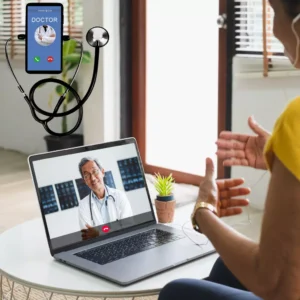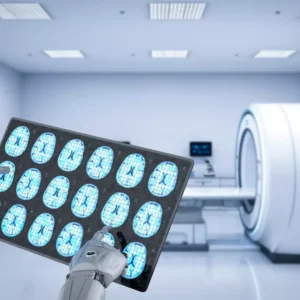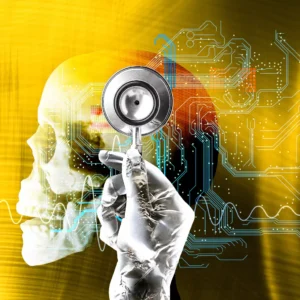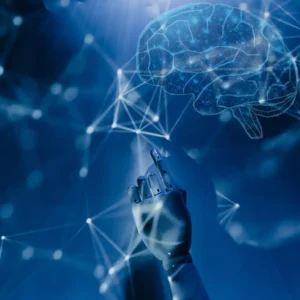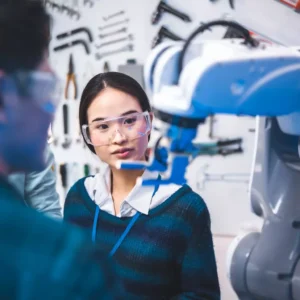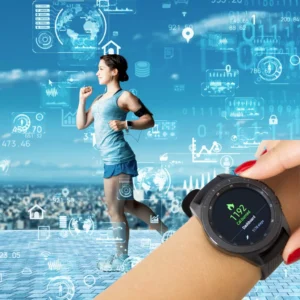
Personalized Recovery Pathways
AI in Rehabilitation
Rehabilitation has long been a cornerstone in healthcare, guiding countless individuals on their journey to recovery. Yet, as with many sectors, modern challenges persist, demanding innovative solutions. Enter AI in Rehabilitation.
This transformative technology is not merely a buzzword; it’s setting new paradigms in recovery pathways. The landscape is shifting from AI-driven physiotherapy tools that enhance precision to predictive analytics that anticipate patient needs.
The age of one-size-fits-all therapy is gradually receding, making way for personalized treatment plans tailored by advanced algorithms. Virtual rehab assistants and wearable tech are blurring the lines between traditional and futuristic care, offering real-time feedback that was once a distant dream.
However, with great potential comes inherent ethical dilemmas and economic considerations. As we embark on this exploration, we’ll delve into patient experiences, equip rehab specialists for what’s next, and envisage the future of Rehabilitation in an AI-driven world. Let’s begin this fascinating journey!
Table of Contents

Arindam Roy
An Automation Consultant with 25+ years of IT Experience
Modern Challenges in Rehabilitation
Rehabilitation, a crucial component in the healthcare sector, has always been about restoring function and improving the quality of life. However, in today’s rapidly changing world, numerous challenges are surfacing.
For one, a growing number of patients, due to an ageing global population leads to a higher demand for rehabilitation services. Traditional methods often need help to cater to the varied needs of this expanding demographic, leaving gaps in care. This challenge is exacerbated by the diverse range of conditions that require Rehabilitation, including sports injuries and stroke recovery. Creating a one-size-fits-all solution for such a diverse patient base is impractical and often ineffective.
Moreover, there’s a pressing need for real-time monitoring and feedback during rehab sessions. Patients and therapists yearn for methods that can provide instant insights into the effectiveness of exercises and treatments. However, conventional rehab often lacks the tools to offer immediate feedback, slowing recovery.
Cost is another pressing concern. Comprehensive rehab can be expensive, putting immense strain on healthcare systems and often out of reach for many individuals. Furthermore, geographical barriers sometimes limit access to quality rehabilitation services, with remote regions facing a dearth of skilled professionals.
AI in Rehabilitation promises a potential solution to these challenges. By leveraging the power of artificial intelligence, can we craft personalized recovery pathways that adapt to individual needs? How might wearable tech and virtual rehabilitation assistants transform the landscape, ensuring consistent and quality care regardless of location?
But as we delve into the solutions, we must first ask: How prepared are we to integrate AI into rehab, and what does this mean for practitioners and patients alike?
AI Tools and Enhanced Recovery
The magic of Rehabilitation lies in its ability to transform lives, aiding individuals as they reclaim their mobility and independence. Yet, the journey to recovery is intricate, calling for precise and tailored interventions. Here’s where AI in Rehabilitation begins its dance.
These tools, built on intricate algorithms, can analyze a patient’s movements in real time. By doing so, they provide invaluable insights, pointing out even the minutest deviations or imperfections. This means more accurate corrections and adjustments, leading to swifter progress.
Parallelly, predictive analytics in Rehabilitation is another game-changer. By gathering and analyzing vast amounts of patient data, AI can anticipate potential setbacks or plateaus in a patient’s recovery journey. This foresight allows therapists to tweak treatment plans proactively, ensuring patients remain on the most effective recovery path. The outcome? Reduced recovery times and a higher chance of achieving optimal results.
Furthermore, the seamless blend of virtual rehabilitation assistants with AI capabilities redefines patient engagement. These virtual aides can guide patients through exercises, monitor their adherence, and even offer feedback, bridging the gap between clinic visits. Such continuity in care ensures that recovery is not limited to the confines of a rehab centre but extends into the comfort of one’s home.
However, as we marvel at these advancements, it’s essential to ponder the integration of these tools in everyday rehab settings. Are there unseen hurdles in the widespread adoption of such technologies? And as we place more trust in AI-enhanced recovery pathways, what safeguards are essential to ensure that technology complements human expertise rather than overshadowing it?
Personalized Therapy and Treatment
Regarding Rehabilitation, there’s a fundamental truth to remember: Every individual’s journey is unique. Age, genetics, medical history, and personal motivation determine how one recovers. Recognizing this, the age of AI in Rehabilitation brings forth the promise of genuinely individualized care.
With the introduction of AI-powered tools, gone are the days of generic rehab routines. Tailoring rehab programs is the new frontier. These programs, designed with the help of AI, take into account a plethora of data points about a patient. From the range of motion to muscle strength past injuries to current pain thresholds, AI systems are constantly learning, adapting, and customizing treatment plans to match each individual’s needs.
Furthering this customization, wearable tech in rehab offers a more hands-on approach. These devices provide a dynamic data flow by continually monitoring a patient’s physiological responses, enabling real-time therapy adjustments. This immediacy ensures that patients are always working at their optimal level, maximizing the benefits of each session.
Yet, as we harness AI to design more refined and specific recovery pathways, there’s a broader question: How do we maintain the human touch in rehab? While algorithms and devices provide precision, recovery’s emotional and psychological aspects are equally crucial. How do we ensure that AI-driven personalized therapy remains holistic, addressing the physical, mental and emotional nuances of each individual’s recovery journey?
The Rise of Virtual Rehab Aids
In the digital age, the boundaries of space and time are becoming increasingly blurred, and Rehabilitation is no exception. With the advancement of AI in Rehabilitation, we’re witnessing an unprecedented surge in virtual solutions that promise to revolutionize how we perceive and receive therapy.
Virtual rehabilitation assistants, underpinned by AI algorithms, are increasingly becoming household names. These virtual companions guide patients through exercises with a precision that mirrors and sometimes surpasses human therapists. Their adaptability ensures that patients, whether at home or on the go, have access to high-quality rehab sessions. This means fewer missed sessions and more consistent progress.
Beyond guiding exercises, these virtual aids come equipped with interactive features. They can respond to patient queries, provide instant feedback, and adapt workouts based on real-time performance. Their continual learning ensures that they evolve with the patient, always staying a step ahead in offering the most suitable interventions.
Additionally, these AI-driven aids offer a solution to one of the most pressing challenges in Rehabilitation: accessibility. For many, geographical constraints or mobility issues can limit regular visits to rehab centres. Virtual aids make quality care accessible from anywhere.
However, embracing this new era of virtual rehab assistance is worth pondering a few critical questions. While they offer undeniable benefits, how do we ensure that patients still receive the human connection essential to recovery? As virtual rehabilitation assistants become prevalent, what measures are in place to ensure the privacy and security of patient data, particularly when sensitive health information is involved?
Integrating Wearables for Real-Time Feedback
Rehabilitation, in its essence, is a dynamic process, constantly evolving with the patient’s progress. In this changing landscape, wearable tech integration in rehab stands out as a beacon of innovation, fuelled by the advancements of AI in Rehabilitation.
Imagine a world where patients don’t just rely on periodic check-ins with therapists but receive continuous feedback. Wearable devices armed with AI capabilities make this vision tangible. These gadgets, worn effortlessly on the body, monitor various parameters such as muscle activity, joint angles, and even sweat levels. The data they harvest is processed in real-time, offering immediate insights into the efficacy of a particular exercise or movement pattern.
This real-time feedback revolutionizes Rehabilitation in multiple ways. Firstly, it empowers patients. They’re no longer in the dark about their progress but can visualize and understand it in tangible terms. This knowledge fosters motivation and adherence to therapy, essential elements in the recovery journey.
Furthermore, wearable tech in rehab bridges the gap between professional guidance and independent practice. With devices monitoring them, patients can confidently engage in rehab exercises at home, knowing that they have a digital guardian, so to speak, ensuring they maintain correct form and intensity.
For therapists, these wearables provide an unparalleled depth of data, allowing them to finetune treatment plans, predict potential challenges, and respond proactively. It’s a win-win, enhancing the quality of care and the recovery speed.
But, as we weave wearable tech more into the rehabilitation fabric, one must pause and reflect: How do we ensure these devices remain accessible to all, transcending economic and social barriers? And as we rely more on this continuous stream of data, how do we balance the benefits of real-time feedback with potential concerns over data privacy and security?
Ethical and Bias Concerns
The transformative potential of AI in Rehabilitation is undoubtedly exhilarating. However, ethical dilemmas and concerns arise, as with any technology deeply intertwined with human lives. With AI-driven interventions, there’s a thin line between innovative care and potential pitfalls.
One of the foremost concerns is bias. AI systems, including those used in rehab, are trained on vast data sets. AI can inadvertently prioritize or favour one demographic over another if these datasets aren’t diverse or reflect the global population. This can result in tailoring rehab programs that might be more suited for one group, leaving others at a disadvantage. Such biases can have severe repercussions for a domain as crucial as Rehabilitation, where every individual’s journey matters.
Moreover, the question of data privacy is paramount. While offering invaluable insights, wearable tech in rehab and virtual assistants also gather profoundly personal information about a patient’s health. Ensuring that this data remains confidential and isn’t susceptible to misuse is an ethical obligation for all stakeholders involved.
While AI can guide, predict, and adapt, the human touch, the empathetic connection between therapist and patient, is irreplaceable. Striking a balance between tech-driven and human-centric care is an ethical challenge that professionals must navigate.
These concerns underscore the importance of developing AI in Rehabilitation with a conscientious approach, prioritizing innovation and ethical considerations. As we continue to explore the endless possibilities AI brings to rehab, a pivotal question remains: How can we ensure that technology serves every individual equitably, championing inclusivity and respect at every step of the rehabilitation journey?
Economic Benefits and Considerations
When dissecting the impact of AI in Rehabilitation, it’s impossible to overlook the significant economic implications. As AI reshapes the landscape of rehab, both in terms of quality and accessibility, there’s a ripple effect on the financial dynamics of healthcare.
Firstly, introducing AI-driven physiotherapy tools and virtual aids can reduce the need for frequent in-person therapist visits. This translates to savings in travel, time, and the costs of face-to-face sessions. For healthcare providers, optimizing resources and expanding patient reach through virtual platforms can lead to higher efficiency and potentially increased revenue streams.
Moreover, the predictive capabilities of AI can be a game-changer. Predictive analytics in Rehabilitation can identify potential challenges or risks early in the treatment process. Addressing issues proactively, rather than reactively, often leads to quicker recovery times and less intensive interventions in the long run. Economically, this means a reduction in prolonged treatments and the associated costs.
However, the economic considerations are not all rosy. Implementing sophisticated AI systems requires substantial initial investment. Training personnel, integrating technology, and maintaining these systems come with their price tags. The financial burden of transitioning to AI-centric models can be daunting for smaller rehab centres.
Additionally, there’s the economic challenge of ensuring that these AI tools, particularly wearable tech in rehab, remain accessible to all strata of society. As we know, economic disparities can lead to healthcare disparities. Ensuring that the economic benefits of AI don’t inadvertently exacerbate these gaps is a crucial consideration.
As we stand at the crossroads of technology and healthcare, pondering the economic implications of AI in Rehabilitation, a vital question emerges: How can we harness the economic advantages of AI while ensuring that its benefits are equitable and accessible to all, regardless of their financial standing?
Preparing Rehab Professionals for the Future
The wave of AI in Rehabilitation isn’t just transforming patient experiences; it’s reshaping rehab professionals’ roles and responsibilities. As AI systems become more integrated into therapy and treatment, professionals must be adept in traditional therapeutic methods and in harnessing modern technology’s power.
The cornerstone of this future readiness is continuous education. Professionals should be familiar with AI-driven physiotherapy tools, understand the workings of predictive analytics, and be competent in using and interpreting data from wearable tech. But it’s more than just understanding the tools and their implications and potential pitfalls.
Beyond technical skills, there’s a pressing need to cultivate a mindset of adaptability. The realm of AI is ever-evolving. What’s cutting-edge today might be obsolete tomorrow. Professionals must be fluid and always willing to learn, unlearn, and relearn.
But it’s not all about the tech. As virtual rehabilitation assistants become common, therapists must emphasize the human aspect of care even more. Machines can guide, but humans empathize. Ensuring patients feel seen, heard, and understood amidst digital interventions is paramount.
Financial investments in training physiotherapists and rehab specialists also play a pivotal role. Organizations must recognize that investing in their staff’s training isn’t just an expense; it’s a long-term investment into the quality of care and the institution’s reputation.
Embracing the AI-driven future, while teeming with opportunities, is also fraught with challenges. As the lines between technology and therapy blur, one wonders: How can rehab professionals maintain the delicate balance between staying technologically advanced and preserving the irreplaceable human touch at the heart of healing?
Patient Testimonials and Case Studies
Integrating AI in Rehabilitation is more than just technological advancements and data points. It’s about real people and their healing, recovery, and empowerment journeys. Patient testimonials and case studies offer invaluable insights, giving a human face to the statistics and algorithms.
Sarah, a 34-year-old marathon runner, suffered a severe knee injury. Traditional therapy was slow and frustrating. Then, she looked into an AI-driven physiotherapy tool that tailored a program specifically for her recovery goals. She could adjust her exercises through real-time feedback, witnessing improvements she hadn’t seen in months. Her testimonial? “It felt like the technology knew my body’s needs better than I did!”
In another case, 58-year-old David, recovering from a stroke, struggled with motivation. Enter a virtual rehabilitation assistant who guided him through exercises and provided cognitive games and mood-boosting activities, making rehab feel less like a chore and more like an engaging challenge.
Yet, while many testimonials sing praises, it’s essential to consider the full spectrum of experiences. Some patients, especially older demographics, felt alienated by tech-heavy interventions. They yearned for the simplicity of traditional methods, sometimes feeling overwhelmed by the barrage of data from wearable tech in rehab.
Case studies also shed light on regional discrepancies. In urban settings, where tech adoption is higher than in rural locations, AI-assisted rehab witnessed more success than in rural areas, where infrastructure and tech familiarity posed challenges.
Stories like Sarah’s and David’s offer hope but underline the importance of patient-centric AI tools. Each patient’s journey is unique, and AI’s role should be to enhance, not replace, the personal touch in Rehabilitation.
Amid the plethora of testimonials, a lingering question emerges: How can we ensure that every patient, regardless of age, tech-savviness, or geographical location, feels supported and empowered by AI in their rehab journey?
Predicting Future Trends
The realm of AI in Rehabilitation is dynamic, mirroring the rapid advances in healthcare and technology. As we project into the future, several exciting trends loom, promising to redefine how we perceive and practice Rehabilitation.
One of the standout trends is the rise of augmented reality (AR) and virtual reality (VR) in rehab. Combined with AI, these technologies will allow patients to immerse themselves in virtual environments tailored to their needs. Imagine a world where stroke victims can practice motor skills in a VR setup that mimics their living room, or athletes can test their physical limits in simulated environments.
Integrating AI-driven physiotherapy tools with biotechnology is another area ripe for exploration. In the future, we might witness AI-driven prosthetics and implants that communicate directly with the brain, restoring or enhancing natural abilities.
Beyond the tech, there’s a growing emphasis on holistic Rehabilitation. Future AI in Rehabilitation tools will likely focus on physical recovery and emotional and psychological well-being. Virtual rehabilitation assistants could become comprehensive wellness coaches, assisting with meditation, stress relief, and cognitive exercises.
As global demographics shift and the world’s population ages, geriatric rehab will emerge. AI tools will be instrumental in providing care to this segment, ensuring older adults can maintain a high quality of life.
Yet, as with all forward-looking endeavours, predicting future trends is fraught with uncertainties. While technology promises a plethora of advancements, it’s the human element that will determine their success. Will we balance embracing AI’s capabilities and maintaining the intrinsic human touch vital for proper healing?
As we contemplate the future, we’re left wondering: In a world teeming with tech-driven possibilities, how will the essence of Rehabilitation evolve, and what role will AI play in shaping its core?
Concluding Thoughts: The Fusion of AI and Rehabilitation
The journey of AI in Rehabilitation has been a tapestry of innovation, hope, and challenges. As we’ve delved into, it’s evident that AI-driven solutions, from AI-driven physiotherapy tools to virtual rehabilitation assistants, are transforming the face of Rehabilitation. They promise faster, more effective, personalized recovery pathways, enhancing the patient experience.
Sarah’s and David’s stories highlighted the transformative power of these tools. However, their experiences stress the importance of marrying AI’s precision with the irreplaceable human touch in care. The rapid rise of tech, including wearable tech integration in rehab, underscores a pressing need: ensuring that everyone, regardless of age or tech prowess, can harness these advancements.
Ethical considerations in AI rehab have rightly been at the forefront. With AI’s potential to reshape recovery comes the responsibility of ensuring fairness, inclusivity, and sensitivity. The economic landscape, too, is shifting. The financial implications of AI-driven recovery suggest a more cost-effective future but also one that demands investments in infrastructure, training, and technology.
Training physiotherapists and rehab specialists for this AI-augmented future is imperative. As we’ve seen, preparing them isn’t just about introducing them to new tools but instilling an adaptive mindset, ready for an evolving landscape.
Future trends, from AR and VR in rehab to AI’s role in geriatric care, offer tantalizing glimpses of what’s on the horizon. Yet, with all these advancements, the essence of Rehabilitation — holistic well-being, personal touch, and tailored treatment — must remain at its core.
In answer to our recurring query, AI undoubtedly has an expansive role in shaping the future of Rehabilitation. However, its success will be measured by technological milestones and its ability to enhance the human element in healing, not eclipse.
So, as we stand on this technological precipice, the central question remains: How can we ensure that the fusion of AI and Rehabilitation remains patient-centric, holistic, and deeply human at heart?
Related Articles
- AI in Telehealth: Revolutionizing Remote Care
- Navigating the Next: AI’s Role in Healthcare Predictive Analytics
- Transforming Medical Imaging with AI Capabilities in Radiology
- AI in Genetic Data Analysis: Personalizing Medicine
- AI in Diagnostics: A New Era of Precision and Accuracy
- Smart Hospitals: The Role of AI in hospital operations
- Mental Health Tech: AI-powered Mental Health Apps for Assessment and Therapy
- AI-Powered Drug Discovery: A Revolution in Pharma
- Medical Robots Enhanced by AI: Transforming Surgeries and Care
- Wearable Health Tech: AI-driven health wearables
- AI’s role in chronic disease management
- Neural Interfaces and AI: Bridging Minds and Machines
- Digital Health Platforms: The Power of AI Integration
- AI in Epidemiology: Predicting and Controlling Outbreaks
- AI in Rehabilitation: Personalized Recovery Pathways
- AI in Predictive and Preventive Care: A Proactive Approach
- AI in Home Healthcare: Personal Health Management
- Revolutionise Healthcare with IPA Tools: Streamlining Processes, Improving Efficiency, and Enhancing Patient Care
- Other Articles on AI Usage in Healthcare
- Other Articles on AI usage in different industries
Forbes Articles related to AI usage in Healthcare:

